You may have wondered what Rottweiler colors are possible and if there are color combinations to avoid.
As a Rottweiler owner myself, I get confronted with this quite often and there seems to be a surge in Rottweilers that definitely don’t adhere to the breed standard, not only by head shape, build, but also their colors.
Why is that a problem?
Some Rottweiler colors can put your furry companion at risk for health diseases and genetic defects so beware when buying a purebred Rottie.
To help you determine which colors are possible and what exactly they are called, check the following excerpt from the AKC breed standard for the Rottweiler:
Always black with rust to mahogany markings. The demarcation between black and rust is to be clearly defined.
AKC Rottweiler Breed Standard
These are the generally accepted colors for Rottweilers:
- Black and mahogany
- Black and tan
- Black and rust
We’ll go into detail below on how you can distinguish these colors, whether or not there are other rare Rottweiler colors like red, blue, and all black, and how you can spot a poorly bred Rottweiler.
Before that, check the rest of the breed standard in relation to the color and markings:
The markings should be located as follows: a spot over each eye; on cheeks; as a strip around each side of muzzle, but not on the bridge of the nose; on throat; triangular mark on both sides of prosternum; on forelegs from carpus downward to the toes; on inside of rear legs showing down the front of the stifle and broadening out to front of rear legs from hock to toes, but not completely eliminating black from rear of pasterns; under tail; black penciling on toes.
The undercoat is gray, tan, or black.
Quantity and location of rust markings is important and should not exceed ten percent of body color.
Serious Faults-Straw-colored, excessive, insufficient or sooty markings; rust marking other than described above; white marking any place on dog (a few rust or white hairs do not constitute a marking).
AKC Rottweiler Breed Standard
Dogs will be disqualified if the base color is something other than black and if markings are absent. Markings can vary in size though.
That being said, the AKC also states that the Rottweiler should have a docked tail and is excluded from conformation shows if that is not the case.
I’m strongly against this notion and would encourage everybody to question something like that.
Breeds that are born without tails are a different story, but docking the tail even though the dog doesn’t serve a working purpose like hunting makes absolutely zero sense.
The breed standard is good enough for color clarification though, so let’s dive in.
Rottweiler Mahogany Color
The Rottweiler color mahogany is a deep, rich color that looks quite astonishing due to its reddish-brown look.
A mahogany-colored Rottweiler with that rich reddish tone will stand out from the crowd.
Although the degree of mahogany varies, this is certainly not the rarest Rottweiler color, quite the contrary.
It’s pretty common, especially among American Rottweilers.
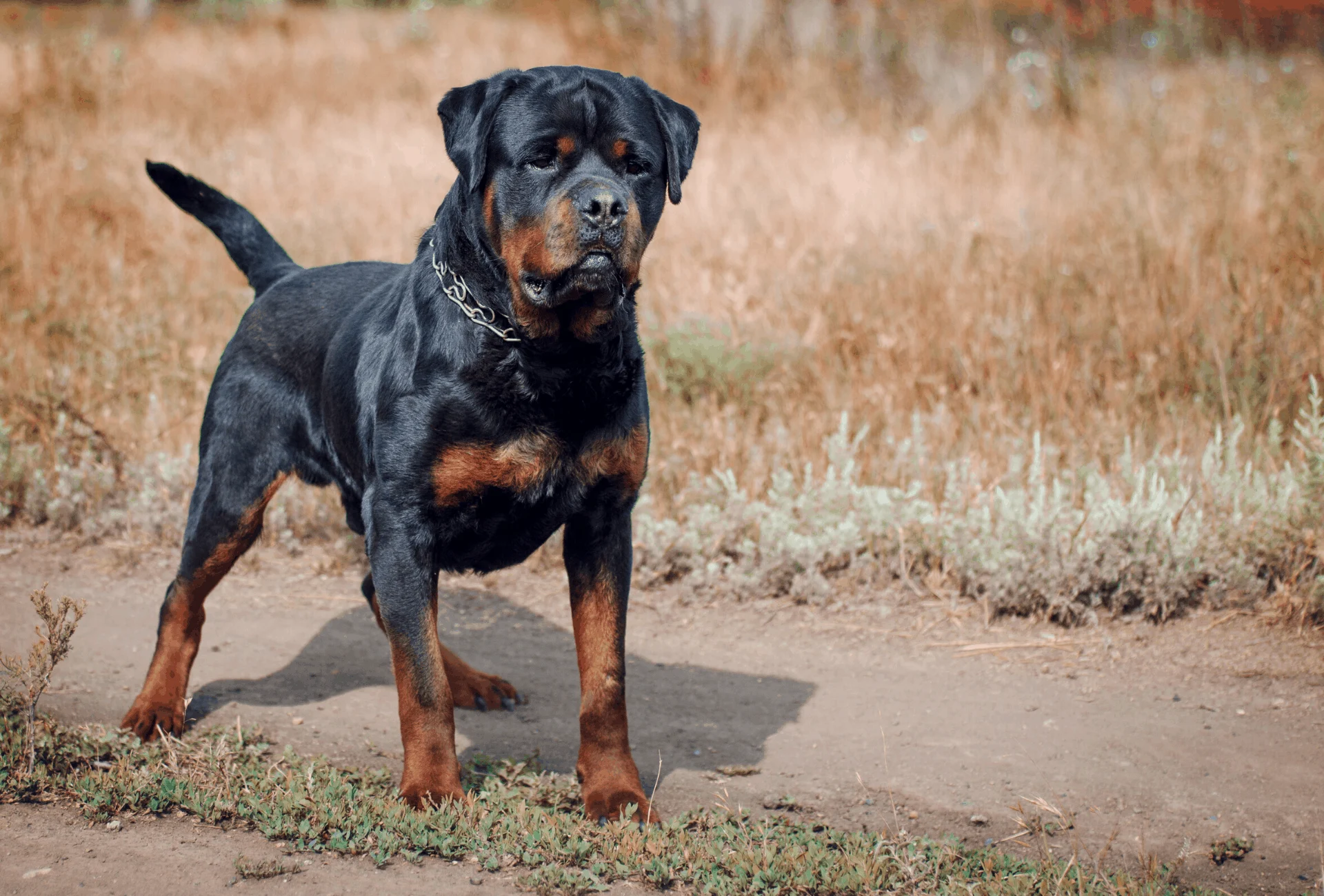
However, it’s important to note the difference between true mahogany and red since it’s possible to mix these up.
Red markings are not allowed and neither is the whole body in red. More on that below.
Black and Rust Rottweiler
The Rottweiler with the color black and rust is actually pretty similar to the one with mahogany, with the difference being that it’s a tad lighter.
However, even experts get these mixed up and with some breeds, rust is the only option to describe this kind of coat color.
The Doberman is one of these and is mentioned with black and rust most often.
This color is quite common for the Rottweiler too.
Black and Tan Rottweiler
My Rottie Amalia is actually black and tan, according to her passport.
You can see her black and tan markings on the paws flowing up to the leg, on the chest, as well as the eyebrow and around the fang.
Deciding between mahogany, rust, or black and tan is just a matter of optics and breeding lines.
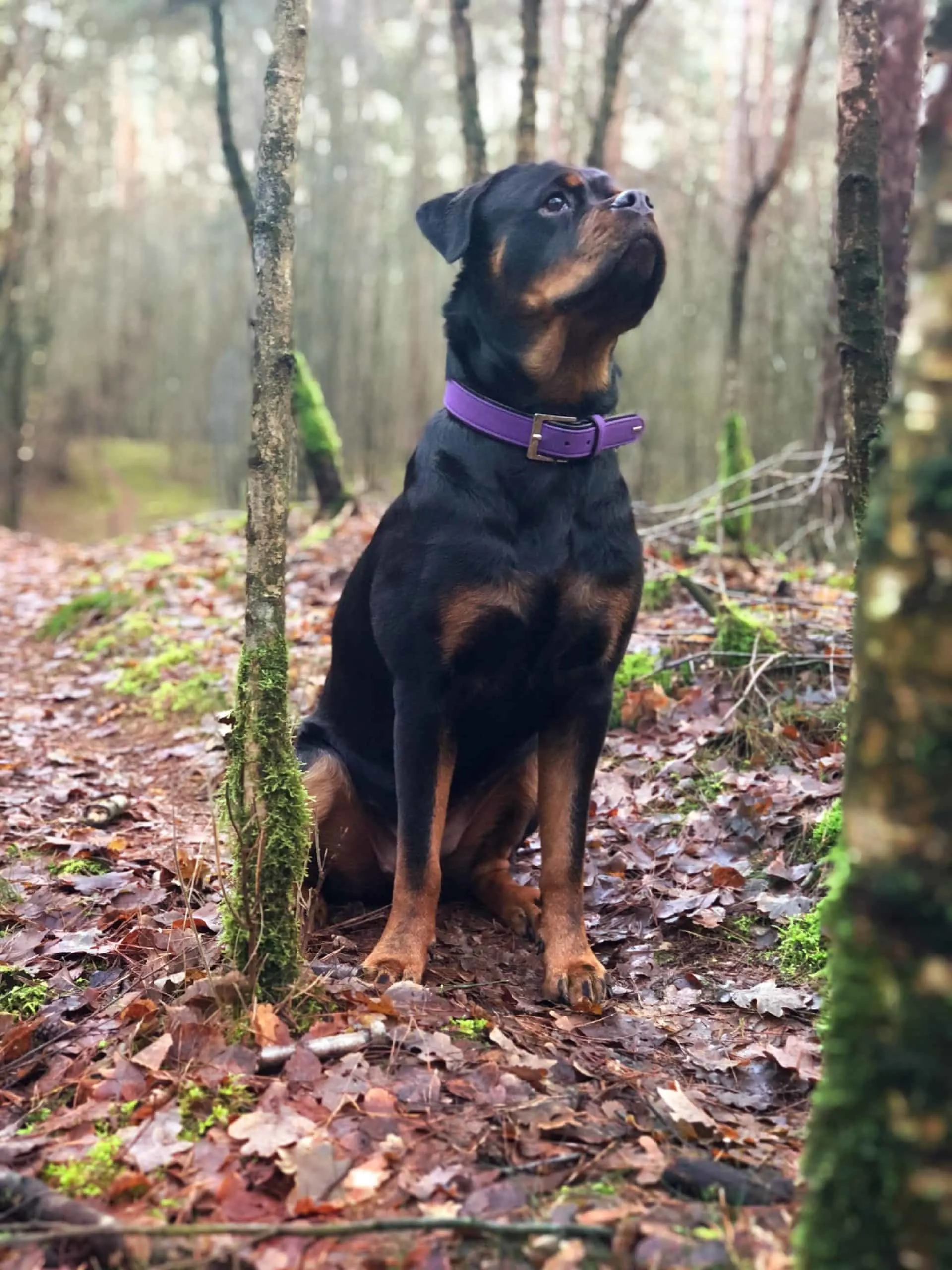
Black and tan is seen quite often in other breeds, but apparently not as often among Rottweiler circles.
Black Rottweiler vs. Light Tan Color
Below is a comparison between a mainly black Rottweiler with rust markings (left) and a very light tan Rottweiler that has bigger markings (right).
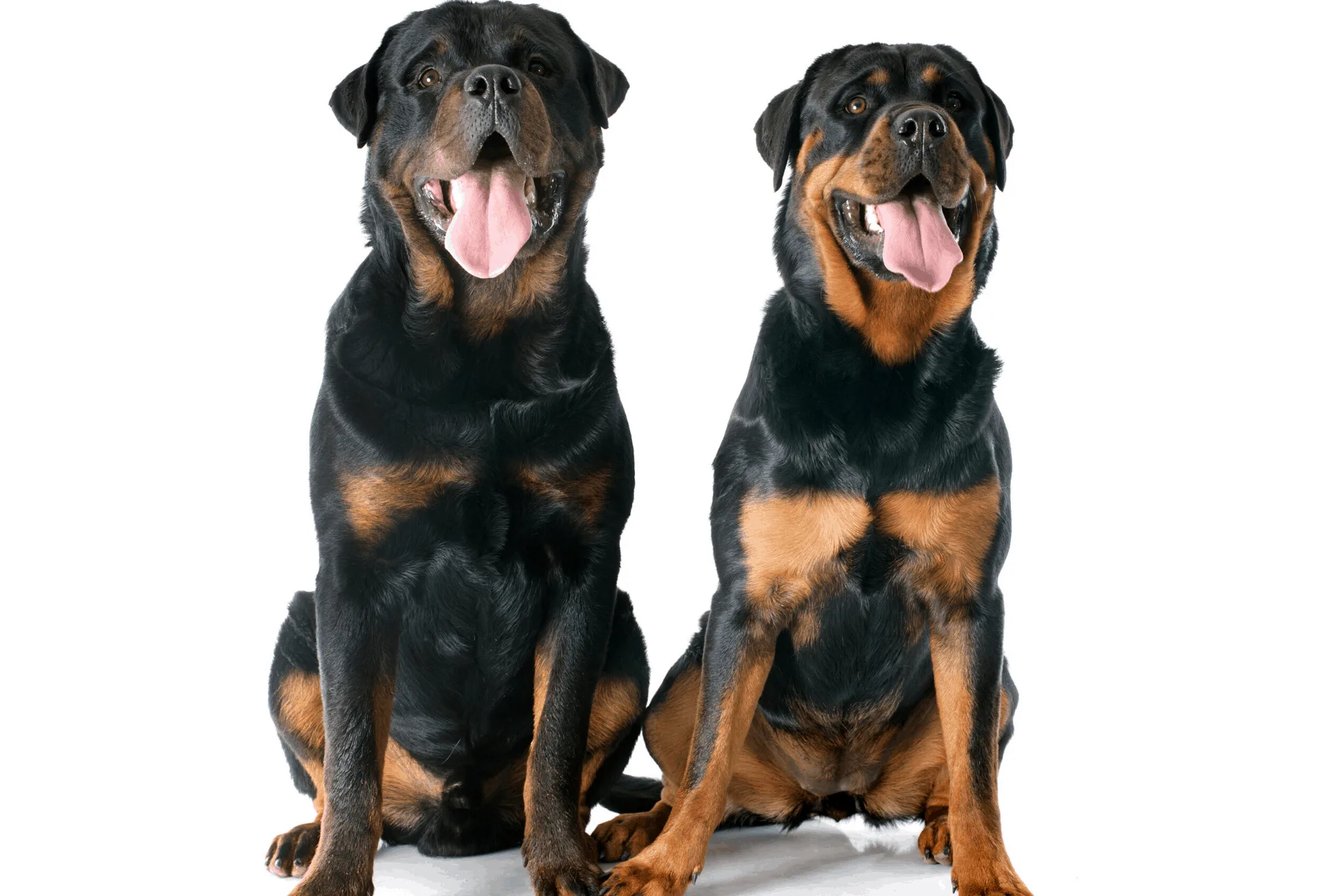
Technically, the black Rottie is not all-black but if you’d only look at the face, it’d be hard to make out the eyebrow markings.
The tan Rottweiler has huge markings on the chest, around the muzzle, as well as on his front and hind legs.
Positioning of the markings of both dogs are correct, they just vary in degree.
Rare Rottweiler Colors
The so-called “rare Rottweiler colors” are not desirable for breeding at all.
It’s important to understand that most of these are crossbreeds and/or carry gene defects which often come with the associated health issues.
You should never choose a dog based on the color anyway.
That being said, if you’re into a specific look, there may be other breeds that fit into your life.
Always make sure to ask your breeder questions about health testing, breeding programs, socialization, and so on.
Do not buy into the scam from irresponsible breeders that advertise their rare Rottweiler colors.
White Rottweiler
A Rottweiler can be white due to various reasons like albinism and vitiligo.
If a dog has albinism, the whole coat will turn white.
However, this defect is not desirable at all and should be avoided at any cost. Read more about albinism and how it relates to the nose color.
In case a Rottweiler has vitiligo, only parts of the coat will turn white with black and tan patches of fur in between.
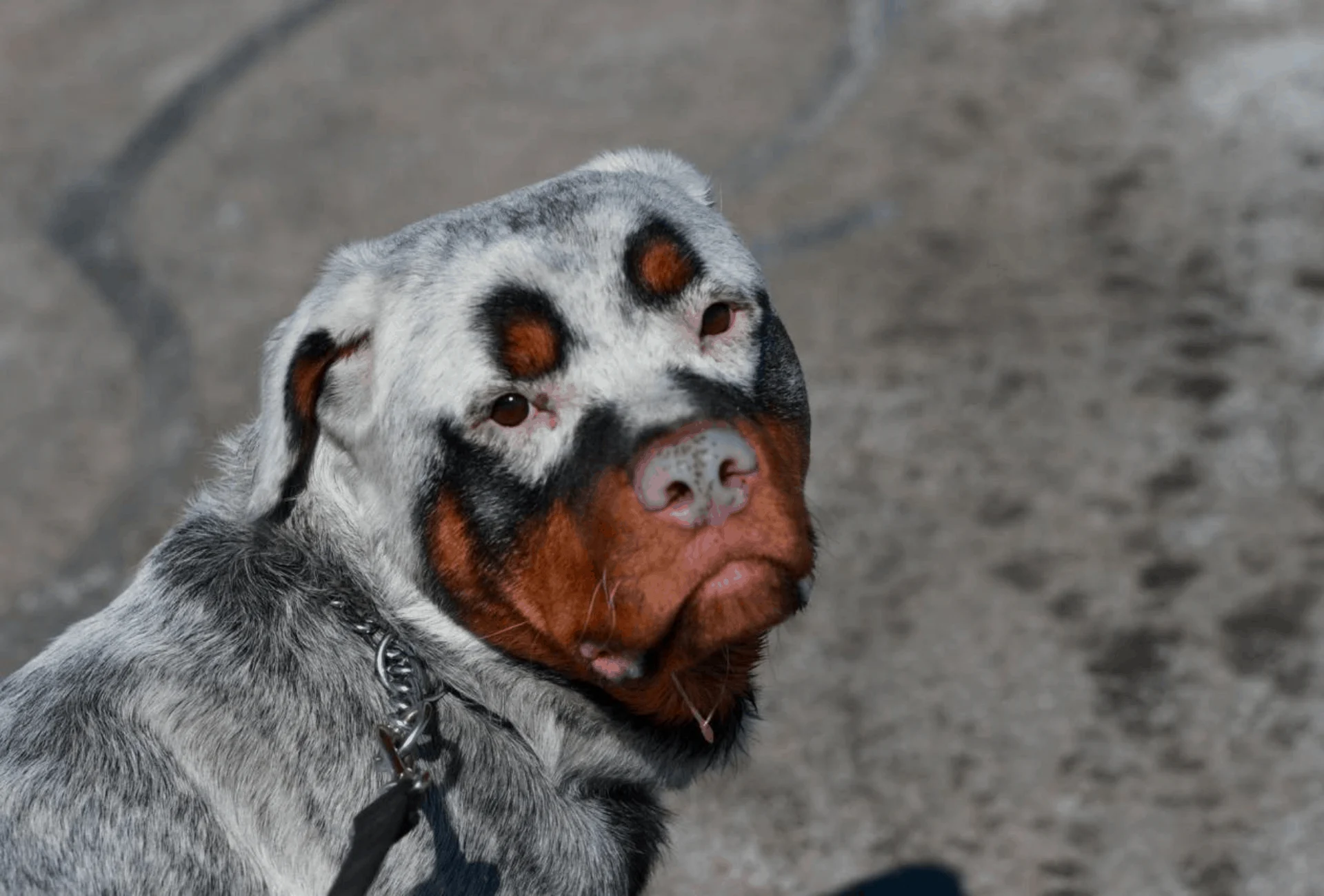
This condition also occurs in humans and is mostly harmless, although undesirable in a breeding program.
In any other case where the dog turns out to be white, it’s most likely a crossbreed.
White Rottweilers do not exist naturally and should not be sold as rare Rottweiler puppies.
Gray Rottweiler
Just like the others on this list, a gray Rottweiler means that it’s most likely a crossbreed.
If a dog inherits the dilute gene from both parents, the dog’s coat can turn out to be gray.
Inheriting this gene is no issue, but the fact that these dogs have been bred with another dog breed points to a non-reputable breeder.
When it comes to genetics, there are many moving parts.
However, the Rottweiler’s base color should always be black.
Although gray does exist in the Cane Corso, it’s often falsely labeled as “blue”, an indication that the breeder knows very little about the breed.
Red Rottweiler
While red Rottweilers have a unique and interesting-looking coat, they are simply the result of crossbreeding.
The look of the rusty brown can be pretty similar to the rare brown Dobermans.
All Black Rottweiler
The all-black Rottweiler is non-existent and is a disqualification according to the AKC (absence of all markings).
However, the black Rottweiler below has very few markings on the underside of his paws and around the muzzle but nearly no eyebrow and chest markings.

Smaller markings are definitely no defect, but they’re quite rare since most breeders try to achieve rich markings on the various spots outlined above.
Rottweiler Colors To Avoid
There are various colors that don’t exactly scream “crossbreed” but they’re just as atypical for the Rottweiler and make me question any breeding program.
Although it’s not exactly detrimental when a dog has the “wrong” color, it can be an indicator of a breeding program that doesn’t have the goal of advancing the breed with healthy and correct types.
With breeders, health testing is the top priority, always.
Completely different story with rescues, of course.
This puppy has very light tan markings, it could be argued that this is not even tan anymore but rather cream, blonde, or another light color.
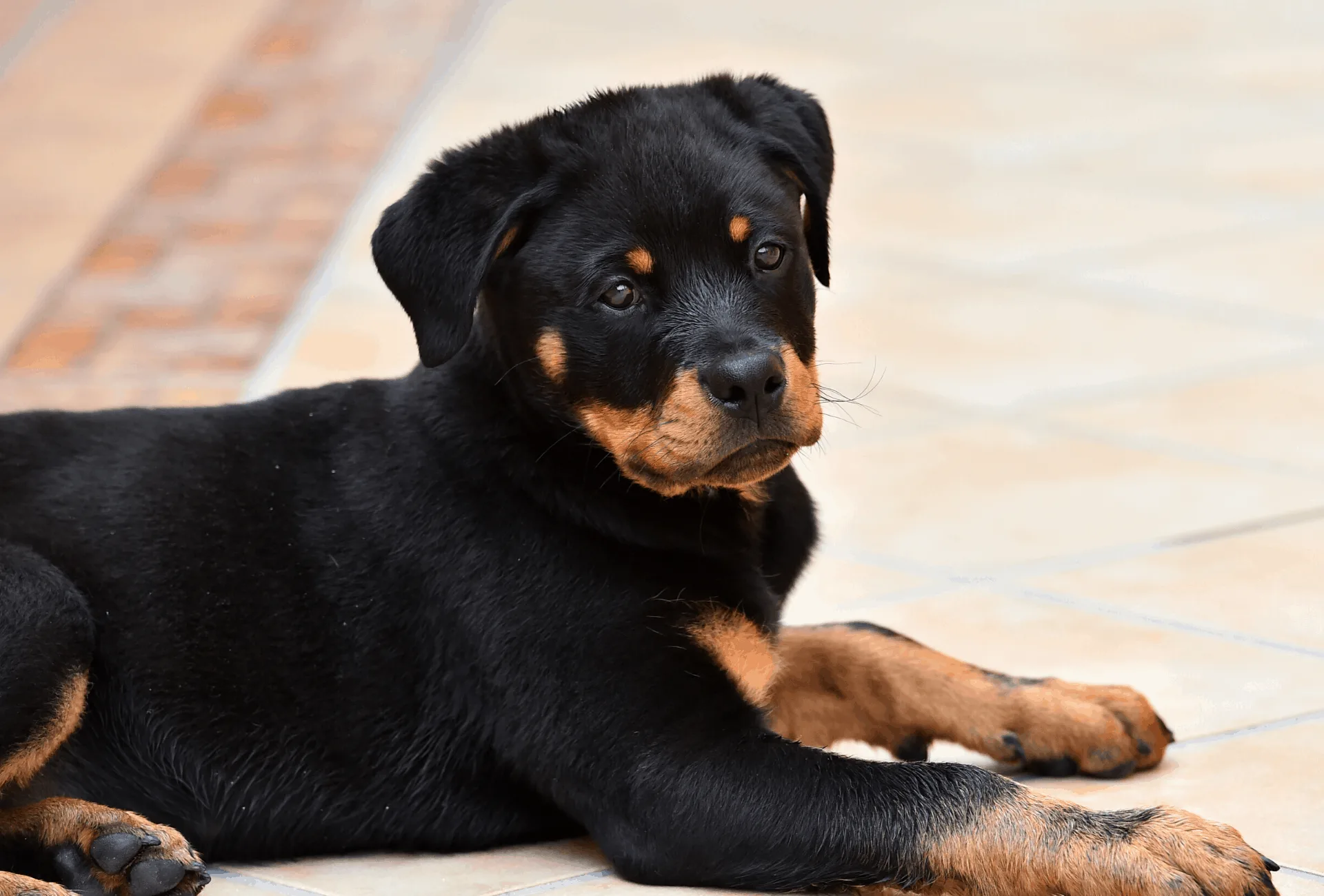
This dog has regular markings, but you can spot shades of brown on his neck which would disqualify the dog according to the AKC breed standard.

These Rottweiler puppies have specs of black on their paws and muzzles.
Although colors may change with age, it’s unlikely that splotches of this kind will disappear.

If you are interested in learning more about dog colors check out The Controversy Around the Blue-Eyed Pitbull.

Pam Boyd
Friday 26th of January 2024
Black and tan is OK but I prefer having bred them from the mid 80s until 2007 black and mahogany. The head should be square as well as the nose the ears should be triangular in shape come out from the head of the top taper down to a rounded point and flip out a little bit at the bottom from the side of the head. The markings should be pure no black spots no white spots there should be no white on the dog at all. And there should be a big perfect Thunderbird across the chest not two dots on either side above the front legs.
Marion sage
Wednesday 29th of June 2022
A friend of mine bred a rotty some time ago that was the rottweiler black but her markings were a really light blonde, (the same shade as a light yellow lab) I saw her but he wouldn't part with her or any of her puppies, my question is how long would it take to breed one with these colors since I don't like the regular rottie colors, just the body type?
PAMELA Greer
Sunday 17th of September 2023
@Danielle, I'm 56. When I turned 18 I had a ROTTWEILER flown into the Unitef states. A true German ROTT. She was 7 mo old. Beautiful mahogany and Black..Kove the muzzle the larger head and the wet mouth ( saggy jawls) so to speak... I raised and bred ROTTWEILERS with my then husband..2 of our dogs were sold to 2 Chicago bears players. Walter Payton and The refrigerator Perry...yep they met us in Diamond Lake Illinois...I'm Talking 1985, 86. We got 2600.00 a piece for them. I'm currently looking for a ROTTWEILER for a companion. Oh did I mention I also train dogs
Danielle
Saturday 2nd of July 2022
Hi Marion,
I have seen Rottweilers with a very light blonde but that was still far from a yellow-colored Lab. You'd need to have two breeding partners with light markings and that could theoretically produce a litter with very light blonde Rotties.
However, I would never advise using that as top-priority criteria. Color should come last, body type shouldn't be the main reason you want to get a Rottie either. You should look out for temperament, trainability, exercise needs and so on.
Brian Hardaway
Saturday 28th of November 2020
I had breed Rotties back in the 80’s and living in Germany, I raised a much larger dog as in the US. I travelled to the birthplace of the Rottweilers, a place called Rottweil to get my first Stud puppy BENO, and Stuttgart for Asta my Bitch. The East German Military were responsible for breeding the dark Rotts because they were harder to detect at night on patrol. But mostly the color was rust, mahogany, or tan, with black. I find the darker ROTTI unattractive. Most have a stocky build and a short nose and face. The dark color also, in my opinion, makes them seem more intimidating. I do know that you can change the pigmentation by feeding carrots with their food. It will make the lighter color darker and the brownish color more intense. That with the tail docking is a AKC Standard for the breed, but in the beginning it was done to protect the dog from injury while pulling the carts. This was the Metzgers (Butchers) dog. They would pull the wagons, and control the cattle. This look became the preferred Standard for the breed. It also gave them a sportier appearance, as with the Dobi. I also docked the tails of my pups after 3-5 days. What I find unacceptable is when the tails are too long or short. But a docked ROTTI, Dobi, Bulldog, or Boxer isn’t as imposing to me. A dog may use its tail to communicate, but without it they can still get their messages across by posturing, smelling, barking, or just the way they approach another dog. Every Mailman knows that a dog that wags his tails does, and can bite. It’s not always a sign of affection. Is it wrong for a Woman to get her breast implants? Is it wrong to cut the dewclaws? They’re definitely not necessary for a dog to have. But very few is said or written about that. Keep information flowing.
Danielle
Tuesday 1st of December 2020
Hi Brian,
thanks for the input. Color (tan, rust, mahogany) and shade of black as well as build and length of the tail or nose (as long as it's not causing respiratory issues) depend on personal preferences.
Yes, I agree that darker Rotties do seem more intimidating to many but so do the cropped ears for the Doberman - that's also pretty subjective and a societal issue, not a behavioral one.
You're also right that they do still communicate but a huge part is communicated via the tail and I wouldn't agree that every mailman knows what a tail wag means - many people still believe tail wagging = happy dog. Even if they do know that a tail wag CAN mean that the dog's not friendly, if the dog still had a tail, it would be much easier to differentiate between the kind of wag (high and stiff or low and unsure, etc.).
Re: Comparison to women with implants. There's a reason for the age restriction and at least they decide that themselves, dogs don't. Also, just because humans are legally allowed to make poor choices doesn't mean that we should make these choices for our canines. Docking dog had a purpose back in the day, but as long as your dog's not working (even then one can argue), there's no real need to dock or crop.
Dewclaws? In Germany, you're not allowed to remove them as long as it's not medically necessary. Just as it's banned to crop or dock in Germany and most European countries. If the dewclaw is a health risk, it'll be removed but if it's not, then it stays on your dog just as the tail and not much is said about the declaw because the downside of removing it is not as big as the potential downside of removing a tail.
Again, thanks for your thoughts! Danielle
Kendria Anderson
Sunday 4th of October 2020
I had a question and as a result, I was directed to this article. I noticed that the Little Tikes Rescue Tales Adoptable Pet Rottweiler plush is a dark brownish color with tan where most Rottweilers are mostly black and tan. Is the dark brownish color accurate?
Danielle
Monday 5th of October 2020
Hi Kendria,
I've just checked the plush toy you're mentioning and it's surely a great toy, but really doesn't reflect the Rottweiler color. It's always black with tan/mahogany/rust/brown (however you'd like to call the degree of brown) markings. Doesn't look like a Rottweiler overall, to be honest. A quick search on Amazon shows more realistic plush toys, depending on what you're looking for, of course :).
Cheers, Danielle